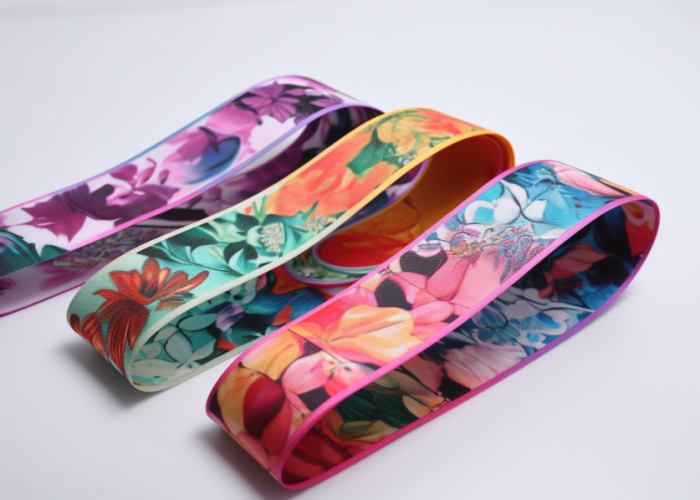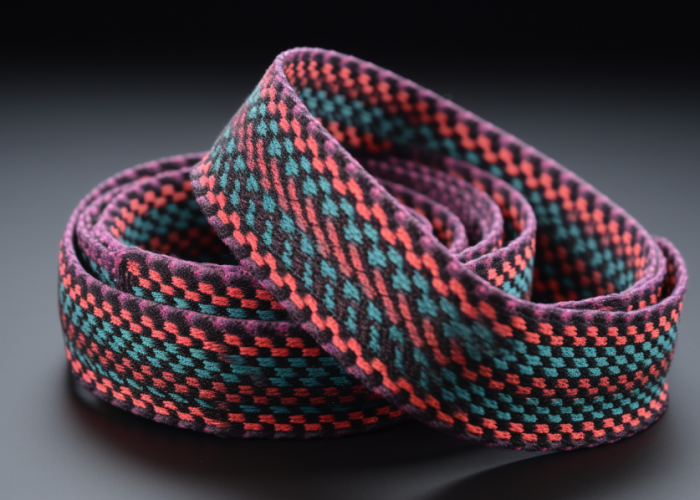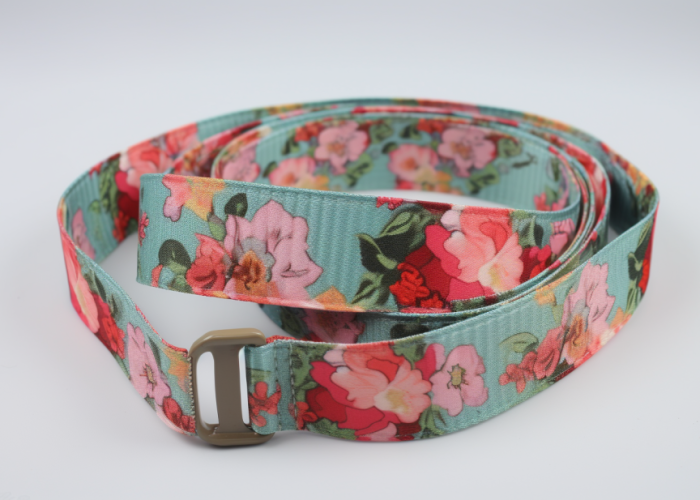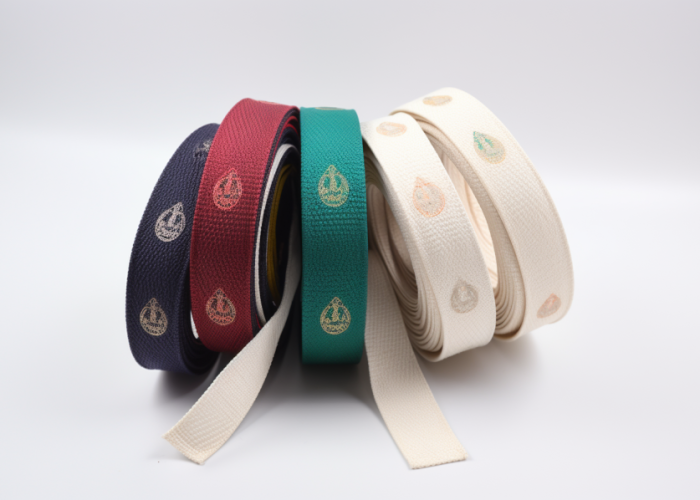As a custom webbing manufacturer specializing in branded bag straps, we regularly work with product developers who struggle to integrate corporate branding seamlessly into functional nylon webbing designs. Many face challenges selecting the right nylon properties, choosing cost-effective branding methods, and ensuring their bag straps meet both aesthetic and performance requirements.
Branded bag straps use nylon webbing with jacquard weaving, heat transfer printing, or embossing to integrate logos and designs. Jacquard weaving embeds patterns into the fabric for durability, heat transfer enables vibrant multi-color prints, and embossing adds tactile, high-end branding. The process includes selecting materials, branding methods, and hardware while ensuring compliance with durability and industry standards.
We’re writing this guide to help you make informed design decisions and optimize your branded bag strap specifications.


Webbing manufacturing expert with 15+ years of experience helping product developers build high-performance straps for industrial, medical, and outdoor use.
Nylon bag straps offer superior tensile strength of 4,200–12,000 lbs/inch, abrasion resistance 3–5x greater than polyester, UV stability maintaining performance after 1,000+ hours, and elasticity enabling 20-30% stretch for shock absorption.
Key Performance Specifications:
Nylon bag straps deliver exceptional tensile strength and durability for demanding applications. High-tenacity constructions exceed baseline values, supporting applications from tactical gear to luxury handbags. Real-world performance shows significantly longer service life in high-friction applications like handbag handles and backpack straps where repeated contact occurs.
The elasticity characteristic reduces stress concentrations at attachment points, making nylon ideal for dynamic loading conditions. However, UV exposure presents design limitations for outdoor applications, requiring accelerated replacement schedules or protective treatments beyond 12-month exposure periods.
Design Takeaway: Specify nylon when tensile strength exceeds 3,000 lbs/inch requirements and abrasion resistance is critical. Account for 20-30% elongation in hardware spacing. For outdoor use beyond 12 months, implement UV protection or consider polyester alternatives.
Jacquard weaving is the best branding method for durability and longevity, while heat transfer works best for multi-color designs, and embossing suits premium tactile applications
Branding Method Capabilities:
Jacquard weaving creates permanent branding by interlacing colored yarns during manufacturing, making logos integral to webbing structure. From producing straps for a tactical equipment manufacturer’s 5-year field deployment, jacquard logos showed no separation after exceeding ASTM D4157 flex testing at 10,000+ cycles. However, color options are limited to yarn availability, and setup requires 200+ yard minimums for economic viability.
Heat transfer bonds polymer inks to nylon surface using thermoplastic adhesion principles. While suitable for promotional applications, we’ve documented adhesion failure in high-abrasion scenarios—a luxury goods client experienced logo peeling after 18 months of daily handbag use. The method excels for prototyping and complex graphics but degrades faster than substrate material.
Embossing deforms nylon using heated dies, creating permanent impressions through polymer flow. A military contractor specified this method for chemical-resistant applications where surface coatings fail, but detail is limited to 0.5mm minimum features due to nylon’s elastic recovery properties.
Design Takeaway: Choose jacquard when logo must match webbing lifespan and withstand extreme conditions, accepting color limitations. Use heat transfer for prototyping and moderate-use applications expecting 12-24 month replacement cycles. Specify embossing for chemical environments requiring subtle, permanent identification.

Choose strap strength based on application: luxury bags need 500-1,000 lbs capacity, backpacks require 2,000-3,000 lbs, and tactical gear demands 4,000+ lbs with appropriate safety factors.
Engineering Selection Criteria:
Proper selection requires calculating actual working loads plus dynamic amplification factors and appropriate safety margins per engineering standards. For a mountaineering equipment client, we specified 22kN-rated webbing for 3kN working loads, meeting UIAA 107 standard requiring 7:1 safety factors. Commercial applications typically use 3:1 margins per ANSI guidelines, but critical safety applications demand higher ratios.
Environmental factors often override strength considerations. A marine hardware manufacturer switched from nylon to polyester after saltwater hydrolysis caused 40% strength loss within 6 months, despite adequate initial load ratings. Temperature cycling affects nylon’s glass transition—testing shows embrittlement below -20°F reducing impact absorption capacity.
Load distribution prevents catastrophic failure modes. From analyzing a recall involving single-point attachment failure, we recommend distributed loading across multiple points for critical applications. Nylon’s 20-30% elongation provides visible warning before failure, unlike brittle materials that fracture suddenly.
Design Takeaway: Calculate maximum expected loads including dynamic factors, apply industry-standard safety margins (3:1 commercial, 7:1+ critical). Prioritize environmental resistance over peak strength for long-term applications. Design attachment systems for gradual failure modes with visible degradation warnings rather than sudden catastrophic failure.
Custom branded bag straps cost $0.45-2.20 per yard depending on method and volume, with jacquard requiring $500-2000 setup but lowest unit costs at volume, while heat transfer costs $50-200 setup with consistent per-unit pricing.
Cost Structure Transparency:
Jacquard setup involves loom programming, yarn preparation, and pattern verification with costs ranging $500-2000 depending on design complexity. For a luxury brand’s 8-color logo, setup reached $1800 but achieved $0.45 per yard at 2000-yard volume. Break-even occurred at 400 yards compared to heat transfer’s consistent $2.20 per yard regardless of quantity.
Heat transfer eliminates loom setup but incurs consistent processing costs plus 15-20% material waste from trimming. A promotional product client paid $1.80 per yard for 100-yard run, while the same design cost $0.55 per yard via jacquard at 1000+ yards. Rush orders add 40-60% premiums since heat transfer requires sequential processing.
Compliance testing adds significant costs—CPSIA lead testing ($150), REACH substance analysis ($300), and colorfastness verification ($200) per colorway. A children’s product manufacturer’s total compliance costs reached $1200 for a 3-color design, representing substantial overhead for small orders.
Design Takeaway: Budget jacquard for volumes exceeding 300-400 yards and long-term production. Use heat transfer for prototyping and small batches under 200 yards. Include compliance testing ($500-1500) and setup costs in initial budgets. Request transparent pricing breakdowns including waste factors and ancillary charges for accurate project planning.

Custom nylon bag straps take 5-7 days for jacquard prototypes, 24 hours for heat transfer samples, and 2-4 weeks for production runs depending on method complexity and order volume.
Production Timeline Breakdown:
Manufacturing timelines depend on method complexity and production queue scheduling. Jacquard requires loom programming and yarn preparation—our experience with a 2000-yard corporate order showed 3-day setup followed by continuous 8-hour production run. Once programmed, jacquard achieves consistent 20-50 yards per minute regardless of pattern complexity.
Heat transfer processes individual pieces sequentially, limiting production speed to 6-20 yards per minute. A 500-piece promotional order required 2 full production days due to temperature cycling requirements and individual handling. Quality inspection occurs post-processing, potentially requiring rework if defects are discovered.
Critical path analysis shows design approval often exceeds manufacturing time. Pantone color matching requires 2-3 days lab verification, while client approval cycles can extend weeks. From manufacturing experience, rushing design approval to meet deadlines typically results in mid-production changes adding 5-7 days regardless of method.
Design Takeaway: Allow 2-3 weeks total timeline including design finalization and color verification. Heat transfer suits urgent orders under 100 yards with 3-5 day turnaround. Jacquard requires longer setup but handles large volumes efficiently. Finalize all design elements before production start to avoid costly timeline extensions.
Yes, we provide complete assembly services from webbing manufacturing to hardware attachment using RF welding and mechanical fastening for finished bag strap delivery ready for integration.
Assembly Service Capabilities:
Our assembly services combine webbing production with hardware integration using multiple attachment methods optimized for different performance requirements. RF welding provides maximum joint strength for compatible thermoplastic materials—testing shows welded joints often exceed base webbing strength. However, this method requires material compatibility and specialized equipment setup.
Mechanical crimping suits mixed-material applications where RF welding isn’t feasible. A luxury goods client required metal hardware with nylon webbing, achieving tested joint strength of 2800 lbs using CPSIA-compliant materials. This method accommodates various hardware types but requires specific tooling for each component style.
Quality assurance follows ANSI/ACCT standards requiring pull-testing on production samples. We destructively test 2% of assemblies to verify joint performance meets design specifications. Documentation includes material certificates and test results for regulated applications requiring traceability.
Assembly adds 3-5 days to production timeline depending on hardware complexity and quantity. Design consultation during specification phase prevents compatibility issues—plastic hardware limits system strength regardless of webbing capacity, while metal components can utilize full webbing performance.
Design Takeaway: Specify complete assembly for single-vendor convenience and integrated quality control. Choose joining method based on material compatibility and strength requirements. Include pull-testing specifications and allow additional timeline for assembly verification. Consider hardware limitations in overall system strength calculations rather than relying solely on webbing ratings.

Nylon bag straps deliver superior tensile strength and abrasion resistance for demanding applications, while jacquard branding provides maximum durability. For outdoor use exceeding 12 months, consider polyester alternatives due to UV degradation. Contact us to explore manufacturing solutions tailored to your bag strap requirements.
Safety standards vary by application and market. Commercial products typically require 3:1 safety factors, while critical applications need 10:1 ratios per ANSI guidelines. CPSIA lead content limits apply to children’s products, and REACH compliance is required for European markets.
Plan 2-3 weeks total including design approval, color matching, and production. First-time orders may require additional setup verification time. Heat transfer offers faster turnaround for urgent requirements, while jacquard requires longer setup but handles large volumes efficiently once programmed.
Minimum order quantities start at 50 yards for modern production methods, significantly lower than traditional 800+ yard requirements. Jacquard becomes most economical at 300-500 yards, while heat transfer suits smaller quantities under 200 yards with consistent per-unit pricing.
Choose nylon for maximum tensile strength (4,000+ lbs/inch) and abrasion resistance in indoor or short-term outdoor applications. Select polyester for extended outdoor use exceeding 12 months, as it maintains better UV resistance and strength retention under continuous sun exposure.
Jacquard weaving limits colors to available yarn options but provides maximum durability. Heat transfer enables complex multi-color designs but degrades faster in high-abrasion scenarios. Embossing requires 0.5mm minimum detail and works best with simple geometric logos for chemical-resistant applications.
We follow ISO 9001 quality systems with documented procedures, conduct pull-testing on 2% of assemblies, and provide material certificates for regulated applications. Each production run includes tensile testing verification and dimensional inspection to meet your specifications.